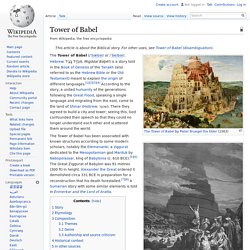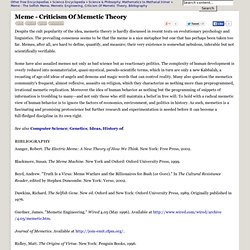

Meme Theory. A meme (/ˈmiːm/ meem)[1] is "an idea, behavior, or style that spreads from person to person within a culture.

"[2] A meme acts as a unit for carrying cultural ideas, symbols, or practices that can be transmitted from one mind to another through writing, speech, gestures, rituals, or other imitable phenomena with a mimicked theme. Supporters of the concept regard memes as cultural analogues to genes in that they self-replicate, mutate, and respond to selective pressures.[3] The word meme is a shortening (modeled on gene) of mimeme (from Ancient Greek μίμημα Greek pronunciation: [míːmɛːma] mīmēma, "imitated thing", from μιμεῖσθαι mimeisthai, "to imitate", from μῖμος mimos "mime")[4] and it was coined by the British evolutionary biologist Richard Dawkins in The Selfish Gene (1976)[1][5] as a concept for discussion of evolutionary principles in explaining the spread of ideas and cultural phenomena. Dawkins' own position is somewhat ambiguous: he obviously welcomed N. History[edit] Memetic Engineering.
Memes mind seen idea To add to the confusion, the modern world has seen an unprecedented multiplication and proliferation of memes, with mass media being the preeminent transmission vector.

Some of these memes are devised with rational ends, such as advertising consumer products; others are devised solely as play; others are "junk" memes. Hula hoops, the Burma Shave billboards of the 1950s, the slogan "There's always room for Jell-O," the synthesizer intro to the 1984 song "Jump" by Van Halen, or the three-note "by Men-nen" jingle, while of no use to those they infect, are excellent examples. The Internet in particular is a virtual memetic petri dish, with examples such as the nonsensical phrase "all your base are belong to us" (from a badly translated 1988 Japanese video game called Zero Wing) spontaneously arising on message boards in 2000, spreading from mind to mind via the ether and then dissipating, not unlike a particularly virulent disease burning its way through the population.
Snow Crash. Tower of Babel. The Tower of Babel (/ˈbæbəl/ or /ˈbeɪbəl/; Hebrew: מִגְדַּל בָּבֶל, Migddal Bāḇēl) is a story told in the Book of Genesis of the Tanakh (also referred to as the Hebrew Bible or the Old Testament) meant to explain the origin of different languages.[1][2][3][4] According to the story, a united humanity of the generations following the Great Flood, speaking a single language and migrating from the east, came to the land of Shinar (Hebrew: שנער).

There they agreed to build a city and tower; seeing this, God confounded their speech so that they could no longer understand each other and scattered them around the world. The Tower of Babel has been associated with known structures according to some modern scholars, notably the Etemenanki, a ziggurat dedicated to the Mesopotamian god Marduk by Nabopolassar, king of Babylonia (c. 610 BCE).[5][6] The Great Ziggurat of Babylon was 91 metres (300 ft) in height.
Story German Late Medieval (c. 1370s) depiction of the construction of the tower. Themes. Meme - Criticism Of Memetic Theory - York, Oxford, Press, Memetics, Human, and Memes. Despite the cult popularity of the idea, memetic theory is hardly discussed in recent texts on evolutionary psychology and linguistics.

The prevailing consensus seems to be that the meme is a nice metaphor but one that has perhaps been taken too far. Memes, after all, are hard to define, quantify, and measure; their very existence is somewhat nebulous, inferable but not scientifically verifiable. Some have also assailed memes not only as bad science but as reactionary politics. The complexity of human development is overly reduced into nonmaterialist, quasi-mystical, pseudo-scientific terms, which in turn are only a new Kabbalah, a recasting of age-old ideas of angels and demons and magic words that can control reality. Many also question the memetics community's frequent, almost reflexive, assaults on religion, which they characterize as nothing more than preprogrammed, irrational memetic replication. Journal of Folklore Research, Meme Theory.
The Journal of Aesthetics and Art Criticism.